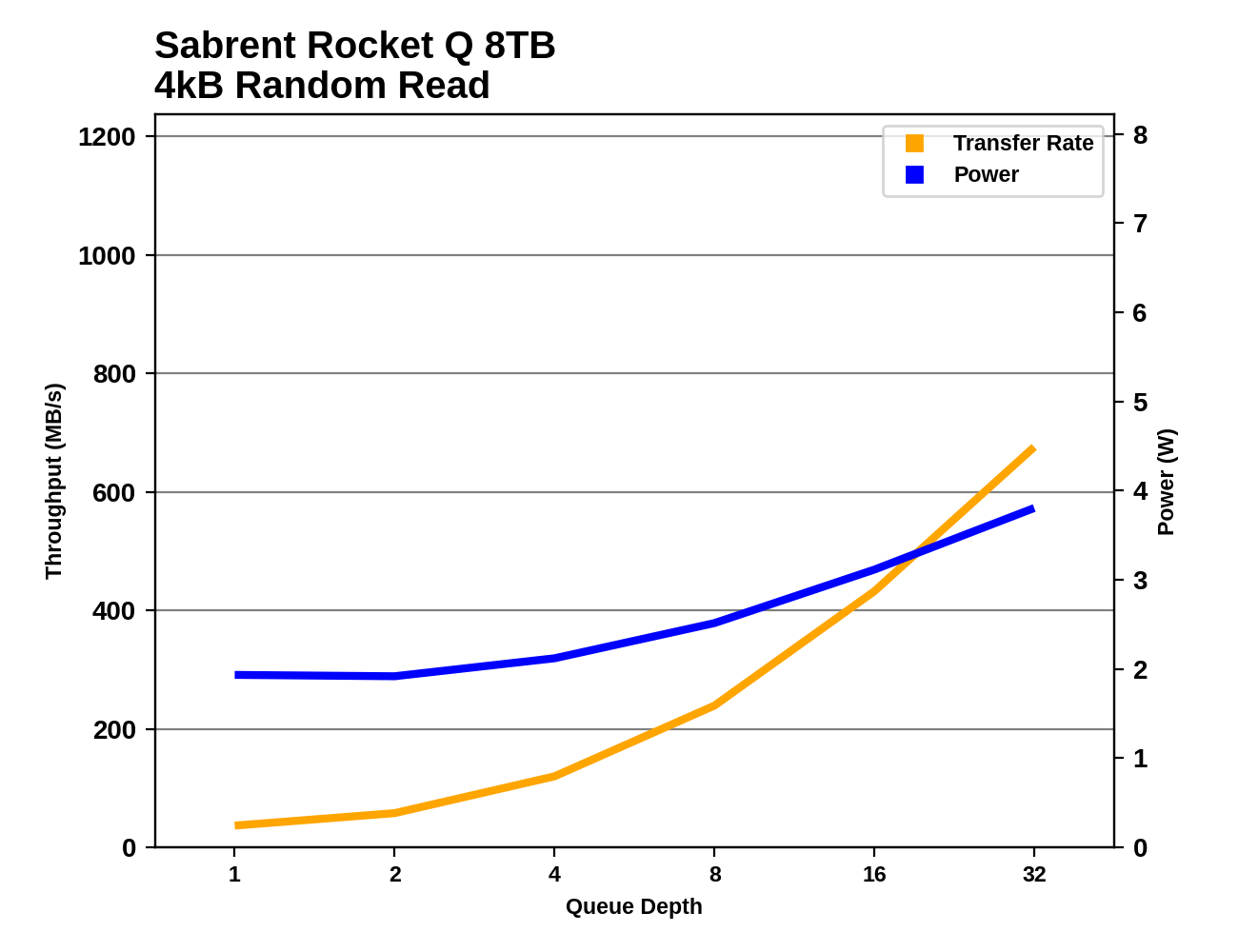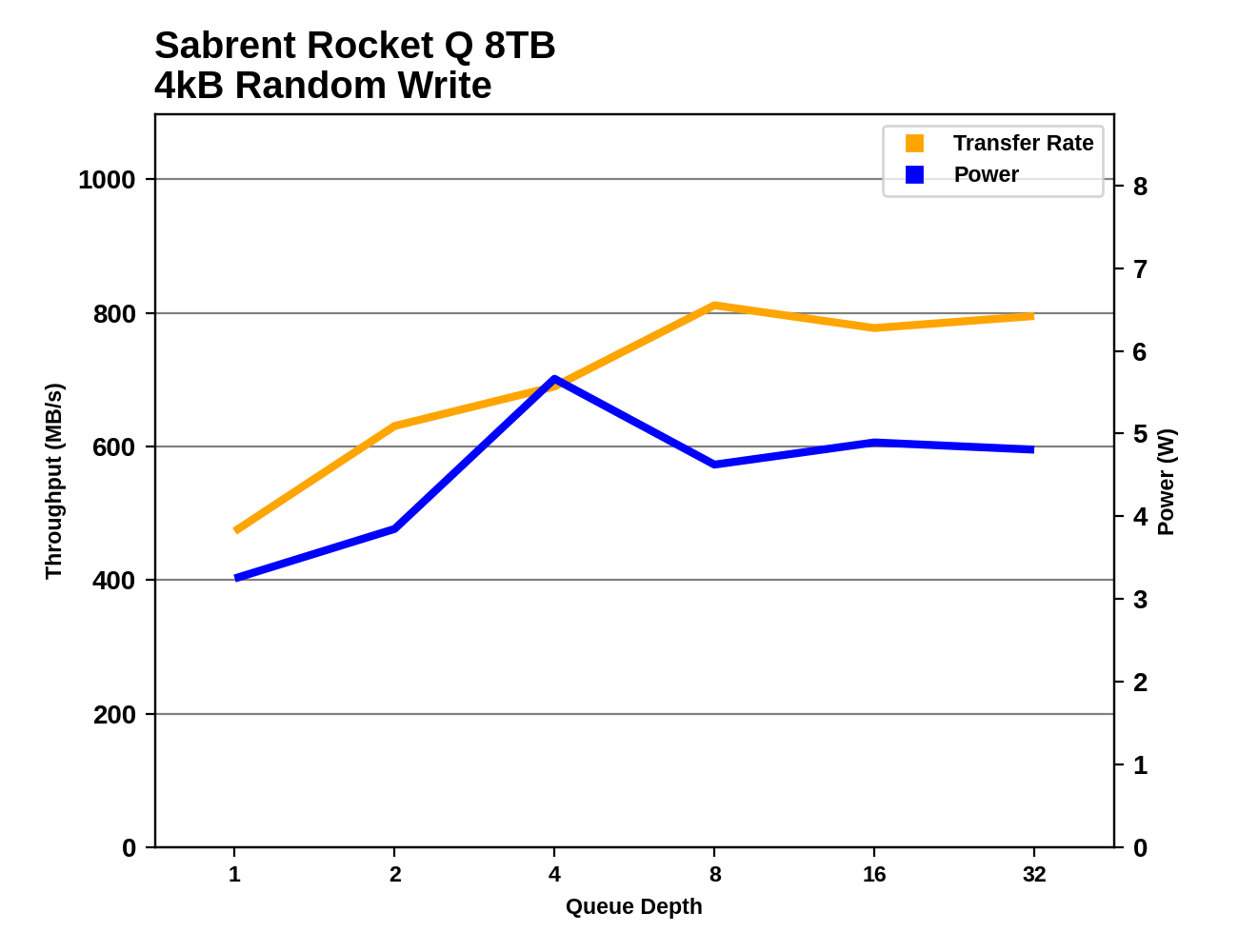QLC Goes To 8TB: Samsung 870 QVO and Sabrent Rocket Q 8TB SSDs Reviewed
by Billy Tallis on December 4, 2020 8:00 AM ESTRandom Read Performance
Our first test of random read performance uses very short bursts of operations issued one at a time with no queuing. The drives are given enough idle time between bursts to yield an overall duty cycle of 20%, so thermal throttling is impossible. Each burst consists of a total of 32MB of 4kB random reads, from a 16GB span of the disk. The total data read is 1GB.

The burst random read performance from the 8TB Samsung 870 QVO is even worse than the smaller 870s; even though these drives have the full amount of DRAM necessary to hold the logical to physical address mapping tables, there are other significant sources of overhead affecting the higher capacity models.
The Sabrent Rocket Q's burst random read performance doesn't quite fall at the opposite end of the spectrum, but it does clearly offer decent random read latency that is comparable to other drives using the Phison E12(S) controller and not too far behind the NVMe drives using Silicon Motion controllers.
Our sustained random read performance is similar to the random read test from our 2015 test suite: queue depths from 1 to 32 are tested, and the average performance and power efficiency across QD1, QD2 and QD4 are reported as the primary scores. Each queue depth is tested for one minute or 32GB of data transferred, whichever is shorter. After each queue depth is tested, the drive is given up to one minute to cool off so that the higher queue depths are unlikely to be affected by accumulated heat build-up. The individual read operations are again 4kB, and cover a 64GB span of the drive.

The QLC drives almost all fare poorly on the longer random read test. The Sabrent Rocket Q falls to be the second-slowest NVMe drive in this batch, and a bit slower than Samsung's TLC SATA drives. The 8TB Samsung 870 QVO is no longer the slowest capacity; while it is again a bit slower than the 4TB model, the 1TB 870 QVO takes last place in this test.
 |
|||||||||
| Power Efficiency in MB/s/W | Average Power in W | ||||||||
The power efficiency scores are mostly in line with the performance scores, with the slower drives tending to also be less efficient. The QLC drives follow this pattern quite well. The outliers are the particularly efficient Mushkin Helix DRAMless TLC drive, and the enterprise NVMe SSDs that show poor efficiency because they are underutilized by the low queue depths tested here.
 |
|||||||||
The Sabrent Rocket Q shows good performance scaling as queue depths increase during the random read test. The Samsung 870 QVO seems to be approaching saturation past QD16, even though the SATA interface is capable of delivering higher performance.
 |
|||||||||
| Sabrent Rocket Q 8TB | Samsung 870 QVO 8TB | ||||||||
Comparing the 8TB drives against everything else we've tested, neither is breaking new ground. Both drives have power consumption that's on the high side but not at all unprecedented, and random read performance that doesn't push the limits of their respective interfaces.
Random Write Performance
Our test of random write burst performance is structured similarly to the random read burst test, but each burst is only 4MB and the total test length is 128MB. The 4kB random write operations are distributed over a 16GB span of the drive, and the operations are issued one at a time with no queuing.

The two 8TB drives have opposite results for the burst random write performance test. The 8TB Sabrent Rocket Q it at the top of the chart with excellent SLC cache write latency, while the 8TB Samsung 870 QVO is a bit slower than the smaller capacities and turns in the worst score in this bunch.
As with the sustained random read test, our sustained 4kB random write test runs for up to one minute or 32GB per queue depth, covering a 64GB span of the drive and giving the drive up to 1 minute of idle time between queue depths to allow for write caches to be flushed and for the drive to cool down.

On the longer random write test, the 8TB Rocket Q is still relying mostly on its SLC cache and continues to hang with the high-end NVMe drives. The 8TB 870 QVO is only slightly slower than the other SATA SSDs, and faster than some of the low-end DRAMless TLC NVMe drives.
 |
|||||||||
| Power Efficiency in MB/s/W | Average Power in W | ||||||||
Despite their dramatically different random write performance, the two 8TB QLC drives end up with similar power efficiency that's fairly middle of the road: better than the enterprise drives and the slow DRAMless TLC drives, but clearly worse than the better TLC NVMe drives.
 |
|||||||||
The random write performance of the Rocket Q scales a bit unevenly, but seems to saturate around QD8. Power consumption actually drops after QD4, possibly because the drive is busy enough at that point with random writes that it cuts back on background cleanup work. The Samsung 870 QVO reaches full random write performance at QD4 and steadily maintains that performance through the rest of the test.
 |
|||||||||
| Sabrent Rocket Q 8TB | Samsung 870 QVO 8TB | ||||||||
Unlike on the random read test, the Samsung 870 QVO comes across as having reasonably low power consumption on the random write test, especially at higher queue depths. The Sabrent Rocket Q's power consumption is still clearly on the high side, especially the spike at QD4 where it seemed to be doing a lot of background work instead of just directing writes to the SLC cache.










150 Comments
View All Comments
TheinsanegamerN - Monday, December 7, 2020 - link
"50% of people know what QLC means? Is that a joke? 50% of ATers don't understand what that means"Care to back up your staement with evidence? AT is mostly perused by techie people who understand the difference between SLC, MLC, TLC, and QLC.
at_clucks - Wednesday, December 9, 2020 - link
@TheinsanegamerN, yeah, you're swimming in the evidence. Check out the comment section carefully and you'll see how well the average ATer understands this. Some may know something about "bits per cell, whatever that means", some may know it's less reliable because "it wears out faster whatever that means", so they know the marketing concepts but not what lies underneath them. Most will blindly assume SLC > MLC > TLC > QLC not why or how, not what the cell is, how it works, how many levels of charge it can have, how it's read or how it's written, how they're organized, not the impact of the implementation, controller, firmware, OS, not why exactly wear is a thing, not why writes wear the cell but reads aren't an issue, not what planar/2D vs. 3D means, etc. Being a "techie" today means you *buy* a lot of tech and gloss over some articles with bar charts of which product is faster. That's it.If you want me to give "evidence" of every statement I make prepare to provide answers that have enough references in the footnote to look like a PhD thesis.
In the meantime it's all but guaranteed that a regular consumer has no clue what QLC means or that the product name is a reference to QLC. They see an SSD that fits their computer, has a certain capacity, and costs a certain price. Maybe the manufacturer on the label alleviates their concerns.
Knowing QLC has less endurance than SLC ("wears out") or that this is slower than that doesn't mean you understand the tech more than knowing some cars drive faster than others or have lower safety ratings makes you a piston head or mechanic.
ripbeefbone - Friday, December 11, 2020 - link
you're way too onlineOxford Guy - Sunday, December 6, 2020 - link
In large part because product pushers like slickdeals don't list the type of NAND in the listing title.This is the opposite of how manufacturers wanted to use LED to push TV sales so LED was always listed in product listings.
People become aware of what manufacturers want them to become aware of. That's why we have so many marketing programs generating graduates all over the world.
Samus - Sunday, December 6, 2020 - link
Fortunately we know, and we know to stay away from this crap at this price. An 8TB 870 EVO is "worth" $600 to me and that's all I'm willing to pay for a drive that should logically cost much less than 8x1TB SSD's, not the SAME EXACT PRICE at 8x1TB SSD's (the 870 QVO 1TB regularly sells for $80-$90, and is currently $90 at Best Buy.Using Samsung's metric to scale, an 8TB hard drive should cost $400. The controller, DRAM and overall package are the same between drives. The only difference is platters\NAND.
Oxford Guy - Tuesday, December 8, 2020 - link
We knowing is irrelevant because consumer ignorance working in manufacturers’ favor is about the bulk of consumer demand not a small number of people who make extra effort to learn specs manufacturers don’t want us to know about and therefore choose to not push.Oxford Guy - Sunday, December 6, 2020 - link
"Every one of those deals has people saying no to QLC."Apples and oranges. The listing titles don't list the type of NAND.
Oxford Guy - Sunday, December 6, 2020 - link
There is also the trick of them calling TLC and QLC "MLC". Technically, it is multi-layer NAND so they can get away with it, even though it is completely shady.shabby - Sunday, December 6, 2020 - link
First company to do that will be stoned to death.Samus - Monday, December 7, 2020 - link
Do you really think the 860 EVO is MLC like it is advertised as? No, “3-bit” VNAND or more commonly known as TLC. Samsung has been calling TLC [MLC] for years and has it been stoned to death yet.